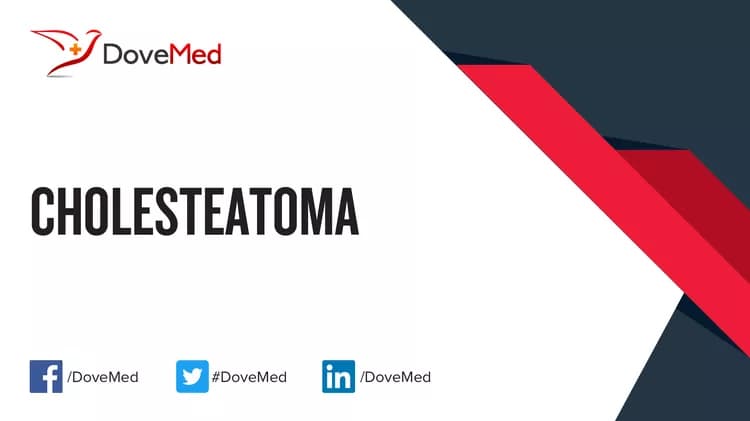What are the other Names for this Condition? (Also known as/Synonyms)
- Congenital Cholesteatoma
- Primary Acquired Cholesteatoma
- Secondary Acquired Cholesteatoma
What is Cholesteatoma? (Definition/Background Information)
- Cholesteatoma is an abnormal growth of skin in the middle ear behind the eardrum. It can be congenital (present from birth), but it more commonly occurs as a complication of chronic ear infections
- Individuals with this condition usually experience a painless discharge from the ear. Hearing loss, dizziness, and facial muscle paralysis are rare but can result from continued Cholesteatoma growth
- Treatment usually involves surgery to remove the growth
(Source: Cholesteatoma; Genetic and Rare Diseases Information Center (GARD) of National Center for Advancing Translational Sciences (NCATS), USA.)
Who gets Cholesteatoma? (Age and Sex Distribution)
- Cholesteatoma is a rare disorder that may be congenital in nature, in some cases. The presentation of symptoms may occur at any age
- Both males and females may be affected
- Worldwide, individuals of all racial and ethnic groups may be affected
What are the Risk Factors for Cholesteatoma? (Predisposing Factors)
The risk for Cholesteatoma may include:
- A congenital abnormality in the development of the middle ear
- Recurrent ear infections
It is important to note that having a risk factor does not mean that one will get the condition. A risk factor increases one’s chances of getting a condition compared to an individual without the risk factors. Some risk factors are more important than others.
Also, not having a risk factor does not mean that an individual will not get the condition. It is always important to discuss the effect of risk factors with your healthcare provider.
What are the Causes of Cholesteatoma? (Etiology)
- A Cholesteatoma is usually caused by poor eustachian tube function in combination with infection in the middle ear
- When the eustachian tube is not working correctly, pressure within the middle ear can pull part of the eardrum the wrong way, creating a sac or cyst that fills with old skin cells
- If the cyst gets bigger, some of the middle ear bones may break down, affecting hearing
Rarely, a congenital form of Cholesteatoma (one present at birth) can occur in the middle ear and elsewhere, such as in the nearby skull bones.
(Source: Cholesteatoma; Genetic and Rare Diseases Information Center (GARD) of National Center for Advancing Translational Sciences (NCATS), USA.)
What are the Signs and Symptoms of Cholesteatoma?
The signs and symptoms of Cholesteatoma may include:
- Fluid drainage from the ear, sometimes with a foul odor. As the Cholesteatoma enlarges, it can lead to:
- A full feeling or pressure in the ear
- Hearing loss
- Dizziness
- Pain
- Numbness or muscle weakness on one side of the face
- Complications of the central nervous system including:
- A blood clot in certain veins within the skull, including the sigmoid sinus
- A collection of infected material between the outer covering of brain and skull (epidural abscess)
- Inflammation of the tissue that surrounds the brain and spinal cord (meningitis)
(Source: Cholesteatoma; Genetic and Rare Diseases Information Center (GARD) of National Center for Advancing Translational Sciences (NCATS), USA.)
How is Cholesteatoma Diagnosed?
Cholesteatoma is diagnosed on the basis of the following information:
- Complete physical examination
- Thorough medical history evaluation
- Assessment of signs and symptoms
- Examination of ears
- Laboratory tests
- Imaging studies
- Biopsy studies, if necessary
Many clinical conditions may have similar signs and symptoms. Your healthcare provider may perform additional tests to rule out other clinical conditions to arrive at a definitive diagnosis.
What are the possible Complications of Cholesteatoma?
The potential complications of Cholesteatoma may include:
- A collection of pus and other material in the brain (brain abscess)
- Hearing loss in one ear
- Dizziness (vertigo)
- A breakdown of the facial nerves leading to facial paralysis
- Meningitis
- Persistent ear drainage
- Spread of the cyst into the brain
- Recurrence of Cholesteatoma after surgical excision
(Source: Cholesteatoma; Genetic and Rare Diseases Information Center (GARD) of National Center for Advancing Translational Sciences (NCATS), USA.)
How is Cholesteatoma Treated?
- The initial treatment for Cholesteatoma may involve careful cleaning of the ear, antibiotics, and eardrops
- Therapy aims to stop drainage in the ear by controlling the infection
- Large or more complicated Cholesteatomas may require surgery (usually successful)
(Source: Cholesteatoma; Genetic and Rare Diseases Information Center (GARD) of National Center for Advancing Translational Sciences (NCATS), USA.)
How can Cholesteatoma be Prevented?
- Cholesteatoma may not be preventable, if it a developmental abnormality present at birth
- Seeking medical attention to ear infections may help avoid development of Cholesteatoma that develops as a result of such infections
- Active research is currently being performed to explore the possibilities for treatment and prevention of disorders such as Cholesteatoma
- Regular medical screening at periodic intervals with tests and physical examinations are recommended
What is the Prognosis of Cholesteatoma? (Outcomes/Resolutions)
- Cholesteatomas usually continue to grow if not removed. Surgery is typically successful, but occasional ear cleaning by a healthcare provider may be necessary
- Additional surgery may be needed if the Cholesteatoma comes back
- In rare cases, complications may arise that can prolong the time taken for the recovery process
(Source: Cholesteatoma; Genetic and Rare Diseases Information Center (GARD) of National Center for Advancing Translational Sciences (NCATS), USA.)
Additional and Relevant Useful Information for Cholesteatoma:
The following DoveMed website link is a useful resource for additional information:
Related Articles
Test Your Knowledge
Asked by users
Related Centers
Related Specialties
Related Physicians
Related Procedures
Related Resources
Join DoveHubs
and connect with fellow professionals


0 Comments
Please log in to post a comment.